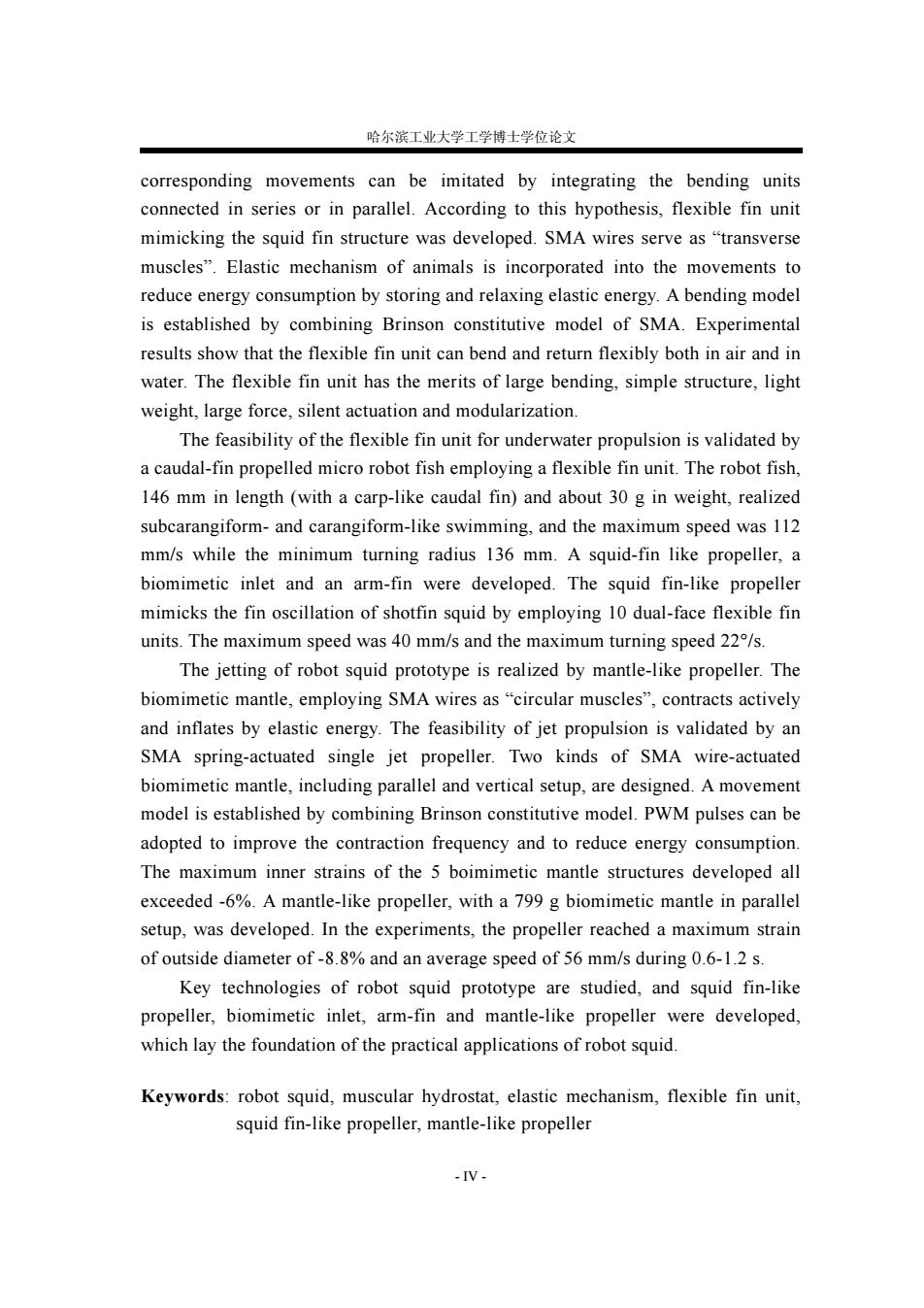
哈尔滨工业大学工学博士学位论文 corresponding movements can be imitated by integrating the bending units connected in series or in parallel.According to this hypothesis,flexible fin unit mimicking the squid fin structure was developed.SMA wires serve as "transverse muscles".Elastic mechanism of animals is incorporated into the movements to reduce energy consumption by storing and relaxing elastic energy.A bending model is established by combining Brinson constitutive model of SMA.Experimental results show that the flexible fin unit can bend and return flexibly both in air and in water.The flexible fin unit has the merits of large bending,simple structure,light weight,large force,silent actuation and modularization. The feasibility of the flexible fin unit for underwater propulsion is validated by a caudal-fin propelled micro robot fish employing a flexible fin unit.The robot fish, 146 mm in length (with a carp-like caudal fin)and about 30 g in weight,realized subcarangiform-and carangiform-like swimming,and the maximum speed was 112 mm/s while the minimum turning radius 136 mm.A squid-fin like propeller,a biomimetic inlet and an arm-fin were developed.The squid fin-like propeller mimicks the fin oscillation of shotfin squid by employing 10 dual-face flexible fin units.The maximum speed was 40 mm/s and the maximum turning speed 22/s The jetting of robot squid prototype is realized by mantle-like propeller.The biomimetic mantle,employing SMA wires as"circular muscles",contracts actively and inflates by elastic energy.The feasibility of jet propulsion is validated by an SMA spring-actuated single jet propeller.Two kinds of SMA wire-actuated biomimetic mantle,including parallel and vertical setup,are designed.A movement model is established by combining Brinson constitutive model.PWM pulses can be adopted to improve the contraction frequency and to reduce energy consumption. The maximum inner strains of the 5 boimimetic mantle structures developed all exceeded-6%.A mantle-like propeller,with a 799 g biomimetic mantle in parallel setup,was developed.In the experiments,the propeller reached a maximum strain of outside diameter of-8.8%and an average speed of 56 mm/s during 0.6-1.2 s. Key technologies of robot squid prototype are studied,and squid fin-like propeller,biomimetic inlet,arm-fin and mantle-like propeller were developed, which lay the foundation of the practical applications of robot squid. Keywords:robot squid,muscular hydrostat,elastic mechanism,flexible fin unit, squid fin-like propeller,mantle-like propeller -V-
哈尔滨工业大学工学博士学位论文 - IV - corresponding movements can be imitated by integrating the bending units connected in series or in parallel. According to this hypothesis, flexible fin unit mimicking the squid fin structure was developed. SMA wires serve as “transverse muscles”. Elastic mechanism of animals is incorporated into the movements to reduce energy consumption by storing and relaxing elastic energy. A bending model is established by combining Brinson constitutive model of SMA. Experimental results show that the flexible fin unit can bend and return flexibly both in air and in water. The flexible fin unit has the merits of large bending, simple structure, light weight, large force, silent actuation and modularization. The feasibility of the flexible fin unit for underwater propulsion is validated by a caudal-fin propelled micro robot fish employing a flexible fin unit. The robot fish, 146 mm in length (with a carp-like caudal fin) and about 30 g in weight, realized subcarangiform- and carangiform-like swimming, and the maximum speed was 112 mm/s while the minimum turning radius 136 mm. A squid-fin like propeller, a biomimetic inlet and an arm-fin were developed. The squid fin-like propeller mimicks the fin oscillation of shotfin squid by employing 10 dual-face flexible fin units. The maximum speed was 40 mm/s and the maximum turning speed 22°/s. The jetting of robot squid prototype is realized by mantle-like propeller. The biomimetic mantle, employing SMA wires as “circular muscles”, contracts actively and inflates by elastic energy. The feasibility of jet propulsion is validated by an SMA spring-actuated single jet propeller. Two kinds of SMA wire-actuated biomimetic mantle, including parallel and vertical setup, are designed. A movement model is established by combining Brinson constitutive model. PWM pulses can be adopted to improve the contraction frequency and to reduce energy consumption. The maximum inner strains of the 5 boimimetic mantle structures developed all exceeded -6%. A mantle-like propeller, with a 799 g biomimetic mantle in parallel setup, was developed. In the experiments, the propeller reached a maximum strain of outside diameter of -8.8% and an average speed of 56 mm/s during 0.6-1.2 s. Key technologies of robot squid prototype are studied, and squid fin-like propeller, biomimetic inlet, arm-fin and mantle-like propeller were developed, which lay the foundation of the practical applications of robot squid. Keywords: robot squid, muscular hydrostat, elastic mechanism, flexible fin unit, squid fin-like propeller, mantle-like propeller
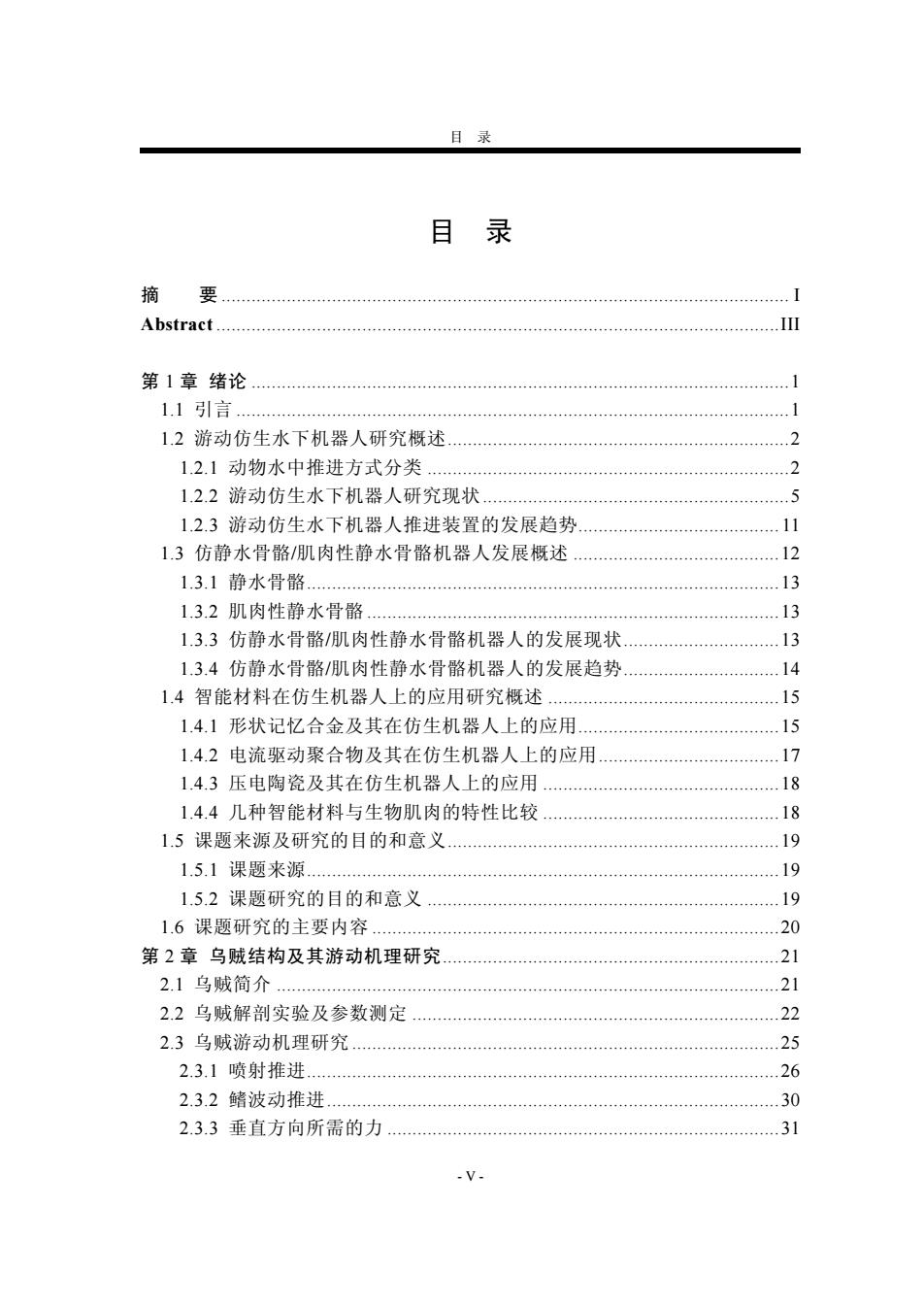
目录 目 录 摘 要 … Abstract. .11 第1章绪论 4… 1.1引言… 1 1.2游动仿生水下机器人研究概述 2 1.2.1动物水中推进方式分类 … 2 1.2.2游动仿生水下机器人研究现状 5 1.2.3游动仿生水下机器人推进装置的发展趋势 .11 1.3仿静水骨骼/肌肉性静水骨骼机器人发展概述 。。 12 1.3.1静水骨骼… .13 1.3.2肌肉性静水骨骼.… 13 1.3.3仿静水骨骼/肌肉性静水骨骼机器人的发展现状 。。, 13 1.3.4仿静水骨骼/肌肉性静水骨骼机器人的发展趋势 14 1.4智能材料在仿生机器人上的应用研究概述 15 1.4.1形状记忆合金及其在仿生机器人上的应用 15 1.4.2电流驱动聚合物及其在仿生机器人上的应用 17 1.4.3压电陶瓷及其在仿生机器人上的应用 18 1.4.4几种智能材料与生物肌肉的特性比较 18 1.5课题来源及研究的目的和意义 … 19 1.5.1课题来源 19 1.5.2课题研究的目的和意义… 19 1.6课题研究的主要内容 20 第2章乌贼结构及其游动机理研究 。。。。。。。。。。。。。。。。。。 21 2.1乌贼简介 21 2.2乌贼解剖实验及参数测定 22 2.3乌贼游动机理研究…...… 25 2.3.1喷射推进. 26 2.3.2鳍波动推进 .30 2.3.3垂直方向所需的力31 .V-
目 录 - V - 目 录 摘 要 ................................................................................................................. I Abstract ................................................................................................................III 第 1 章 绪论 ...........................................................................................................1 1.1 引言 ..............................................................................................................1 1.2 游动仿生水下机器人研究概述....................................................................2 1.2.1 动物水中推进方式分类 ........................................................................2 1.2.2 游动仿生水下机器人研究现状.............................................................5 1.2.3 游动仿生水下机器人推进装置的发展趋势........................................ 11 1.3 仿静水骨骼/肌肉性静水骨骼机器人发展概述 .........................................12 1.3.1 静水骨骼..............................................................................................13 1.3.2 肌肉性静水骨骼 ..................................................................................13 1.3.3 仿静水骨骼/肌肉性静水骨骼机器人的发展现状...............................13 1.3.4 仿静水骨骼/肌肉性静水骨骼机器人的发展趋势...............................14 1.4 智能材料在仿生机器人上的应用研究概述 ..............................................15 1.4.1 形状记忆合金及其在仿生机器人上的应用........................................15 1.4.2 电流驱动聚合物及其在仿生机器人上的应用....................................17 1.4.3 压电陶瓷及其在仿生机器人上的应用 ...............................................18 1.4.4 几种智能材料与生物肌肉的特性比较 ...............................................18 1.5 课题来源及研究的目的和意义..................................................................19 1.5.1 课题来源..............................................................................................19 1.5.2 课题研究的目的和意义 ......................................................................19 1.6 课题研究的主要内容 .................................................................................20 第 2 章 乌贼结构及其游动机理研究...................................................................21 2.1 乌贼简介 ....................................................................................................21 2.2 乌贼解剖实验及参数测定 .........................................................................22 2.3 乌贼游动机理研究 .....................................................................................25 2.3.1 喷射推进..............................................................................................26 2.3.2 鳍波动推进..........................................................................................30 2.3.3 垂直方向所需的力 ..............................................................................31
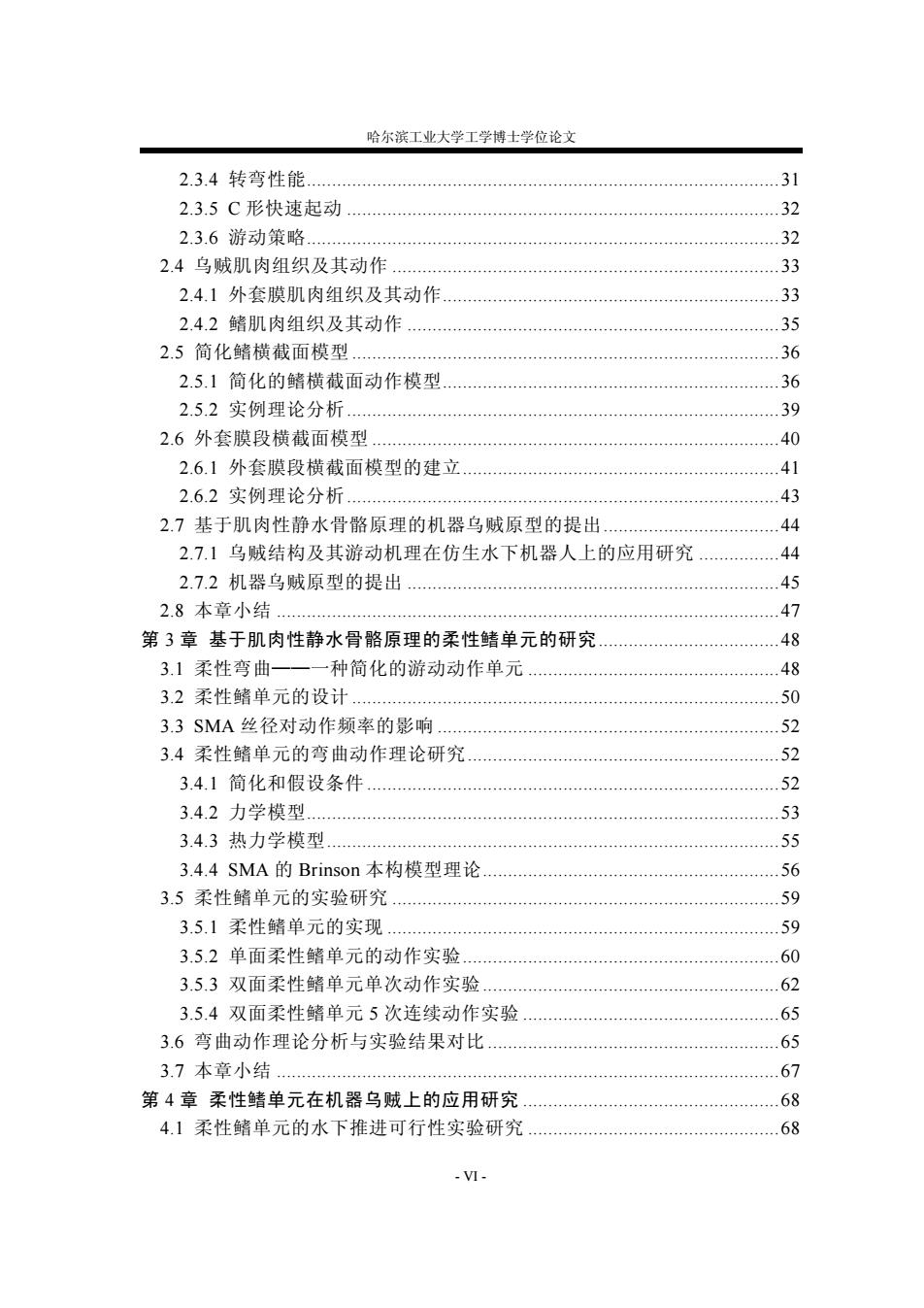
哈尔滨工业大学工学博士学位论文 2.3.4转弯性能 .31 2.3.5C形快速起动 32 2.3.6游动策略 32 2.4乌贼肌肉组织及其动作 33 2.4.1外套膜肌肉组织及其动作 33 2.4.2鳍肌肉组织及其动作 。。。。。。。。。。。。 .35 2.5简化鳍横截面模型 36 2.5.1简化的鳍横截面动作模型 36 2.5.2实例理论分析. 39 2.6外套膜段横截面模型 40 2.6.1外套膜段横截面模型的建立41 2.6.2实例理论分析. 43 2.7基于肌肉性静水骨骼原理的机器乌贼原型的提出 .44 2.7.1乌贼结构及其游动机理在仿生水下机器人上的应用研究 44 2.7.2机器乌贼原型的提出45 2.8本章小结 47 第3章基于肌肉性静水骨骼原理的柔性鳍单元的研究 ..48 3.1柔性弯曲一一一种简化的游动动作单元 48 3.2柔性鳍单元的设计… 50 3.3SMA丝径对动作频率的影响 52 3.4柔性鳍单元的弯曲动作理论研究… 52 3.4.1简化和假设条件 52 3.4.2力学模型. 53 3.4.3热力学模型 55 3.4.4SMA的Brinson本构模型理论 56 3.5柔性鳍单元的实验研究 59 3.5.1柔性鳍单元的实现 59 3.5.2单面柔性鳍单元的动作实验.… 60 3.5.3双面柔性鳍单元单次动作实验 62 3.5.4双面柔性鳍单元5次连续动作实验 65 3.6弯曲动作理论分析与实验结果对比 65 3.7本章小结. 67 第4章柔性鳍单元在机器乌贼上的应用研究 68 4.1柔性鳍单元的水下推进可行性实验研究 .68 -VI-
哈尔滨工业大学工学博士学位论文 - VI - 2.3.4 转弯性能..............................................................................................31 2.3.5 C 形快速起动 ......................................................................................32 2.3.6 游动策略..............................................................................................32 2.4 乌贼肌肉组织及其动作 .............................................................................33 2.4.1 外套膜肌肉组织及其动作...................................................................33 2.4.2 鳍肌肉组织及其动作 ..........................................................................35 2.5 简化鳍横截面模型 .....................................................................................36 2.5.1 简化的鳍横截面动作模型...................................................................36 2.5.2 实例理论分析......................................................................................39 2.6 外套膜段横截面模型 .................................................................................40 2.6.1 外套膜段横截面模型的建立...............................................................41 2.6.2 实例理论分析......................................................................................43 2.7 基于肌肉性静水骨骼原理的机器乌贼原型的提出...................................44 2.7.1 乌贼结构及其游动机理在仿生水下机器人上的应用研究 ................44 2.7.2 机器乌贼原型的提出 ..........................................................................45 2.8 本章小结 ....................................................................................................47 第 3 章 基于肌肉性静水骨骼原理的柔性鳍单元的研究....................................48 3.1 柔性弯曲——一种简化的游动动作单元 ..................................................48 3.2 柔性鳍单元的设计 .....................................................................................50 3.3 SMA 丝径对动作频率的影响 ....................................................................52 3.4 柔性鳍单元的弯曲动作理论研究..............................................................52 3.4.1 简化和假设条件 ..................................................................................52 3.4.2 力学模型..............................................................................................53 3.4.3 热力学模型..........................................................................................55 3.4.4 SMA 的 Brinson 本构模型理论...........................................................56 3.5 柔性鳍单元的实验研究 .............................................................................59 3.5.1 柔性鳍单元的实现 ..............................................................................59 3.5.2 单面柔性鳍单元的动作实验...............................................................60 3.5.3 双面柔性鳍单元单次动作实验...........................................................62 3.5.4 双面柔性鳍单元 5 次连续动作实验 ...................................................65 3.6 弯曲动作理论分析与实验结果对比..........................................................65 3.7 本章小结 ....................................................................................................67 第 4 章 柔性鳍单元在机器乌贼上的应用研究 ...................................................68 4.1 柔性鳍单元的水下推进可行性实验研究 ..................................................68
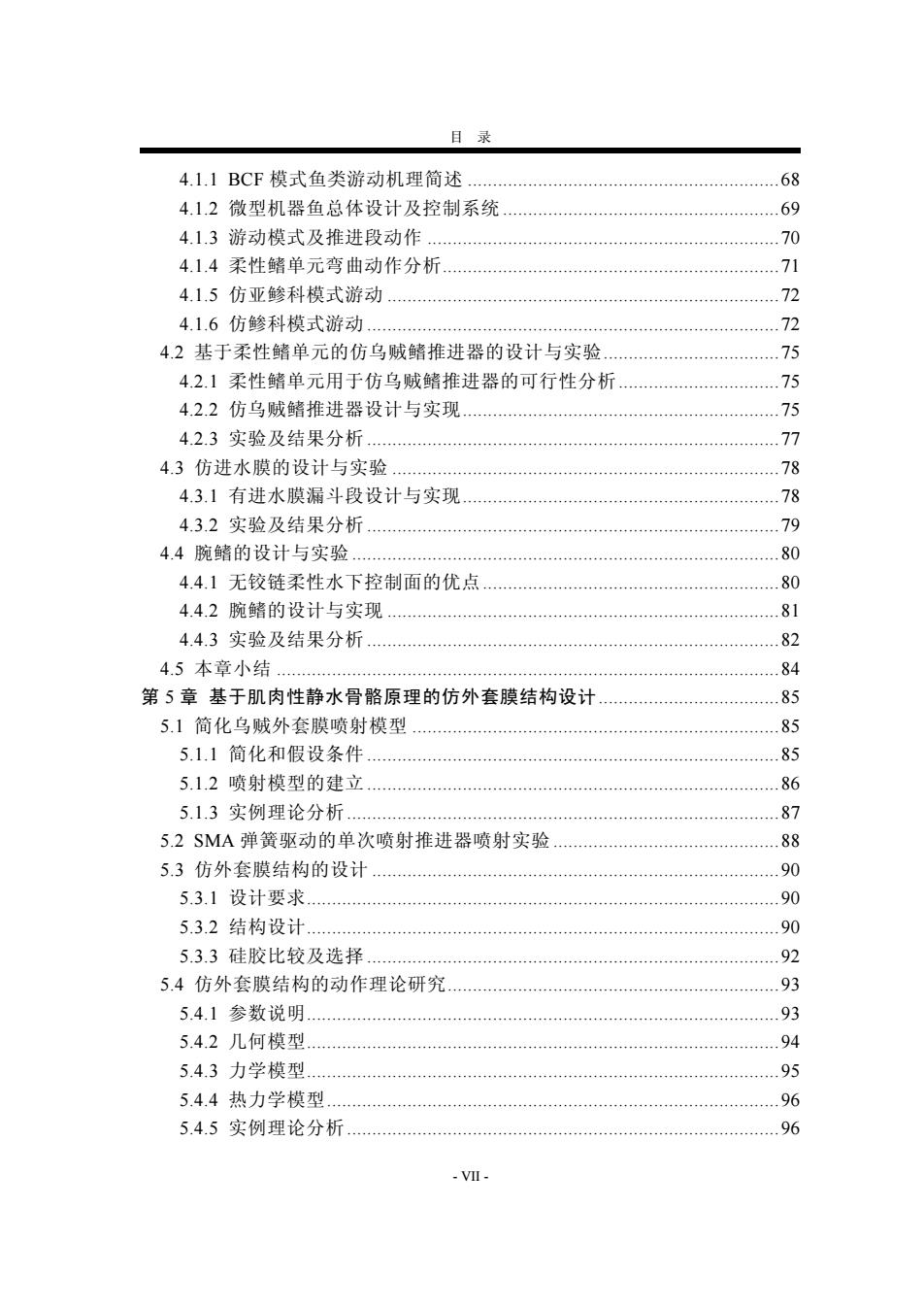
目录 4.1.1BCF模式鱼类游动机理简述 .68 4.1.2微型机器鱼总体设计及控制系统 69 4.1.3游动模式及推进段动作 70 4.1.4柔性鳍单元弯曲动作分析 .71 4.1.5仿亚鲹科模式游动 72 4.1.6仿鲹科模式游动..72 4.2基于柔性鳍单元的仿乌贼鳍推进器的设计与实验 75 4.2.1柔性鳍单元用于仿乌贼鳍推进器的可行性分析 75 4.2.2仿乌贼鳍推进器设计与实现 75 4.2.3实验及结果分析 77 4.3仿进水膜的设计与实验 78 4.3.1有进水膜漏斗段设计与实现 78 4.3.2实验及结果分析 。。 .79 4.4腕鳍的设计与实验 .… 80 4.4.1无铰链柔性水下控制面的优点 80 4.4.2腕鳍的设计与实现 4.4.3实验及结果分析.. .82 4.5本章小结.… 84 第5章基于肌肉性静水骨骼原理的仿外套膜结构设计 85 5.1简化乌贼外套膜喷射模型 85 5.1.1简化和假设条件 85 5.1.2喷射模型的建立 86 5.1.3实例理论分析 87 5.2SMA弹簧驱动的单次喷射推进器喷射实验… 88 5.3仿外套膜结构的设计 90 5.3.1设计要求 90 5.3.2结构设计 90 5.3.3硅胶比较及选择 92 5.4仿外套膜结构的动作理论研究 93 5.4.1参数说明 93 5.4.2几何模型 94 5.4.3力学模型 95 5.4.4热力学模型 .96 5.4.5实例理论分析96 VII
目 录 - VII - 4.1.1 BCF 模式鱼类游动机理简述 ..............................................................68 4.1.2 微型机器鱼总体设计及控制系统 .......................................................69 4.1.3 游动模式及推进段动作 ......................................................................70 4.1.4 柔性鳍单元弯曲动作分析...................................................................71 4.1.5 仿亚鲹科模式游动 ..............................................................................72 4.1.6 仿鲹科模式游动 ..................................................................................72 4.2 基于柔性鳍单元的仿乌贼鳍推进器的设计与实验...................................75 4.2.1 柔性鳍单元用于仿乌贼鳍推进器的可行性分析................................75 4.2.2 仿乌贼鳍推进器设计与实现...............................................................75 4.2.3 实验及结果分析 ..................................................................................77 4.3 仿进水膜的设计与实验 .............................................................................78 4.3.1 有进水膜漏斗段设计与实现...............................................................78 4.3.2 实验及结果分析 ..................................................................................79 4.4 腕鳍的设计与实验 .....................................................................................80 4.4.1 无铰链柔性水下控制面的优点...........................................................80 4.4.2 腕鳍的设计与实现 ..............................................................................81 4.4.3 实验及结果分析 ..................................................................................82 4.5 本章小结 ....................................................................................................84 第 5 章 基于肌肉性静水骨骼原理的仿外套膜结构设计....................................85 5.1 简化乌贼外套膜喷射模型 .........................................................................85 5.1.1 简化和假设条件 ..................................................................................85 5.1.2 喷射模型的建立 ..................................................................................86 5.1.3 实例理论分析......................................................................................87 5.2 SMA 弹簧驱动的单次喷射推进器喷射实验 .............................................88 5.3 仿外套膜结构的设计 .................................................................................90 5.3.1 设计要求..............................................................................................90 5.3.2 结构设计..............................................................................................90 5.3.3 硅胶比较及选择 ..................................................................................92 5.4 仿外套膜结构的动作理论研究..................................................................93 5.4.1 参数说明..............................................................................................93 5.4.2 几何模型..............................................................................................94 5.4.3 力学模型..............................................................................................95 5.4.4 热力学模型..........................................................................................96 5.4.5 实例理论分析......................................................................................96
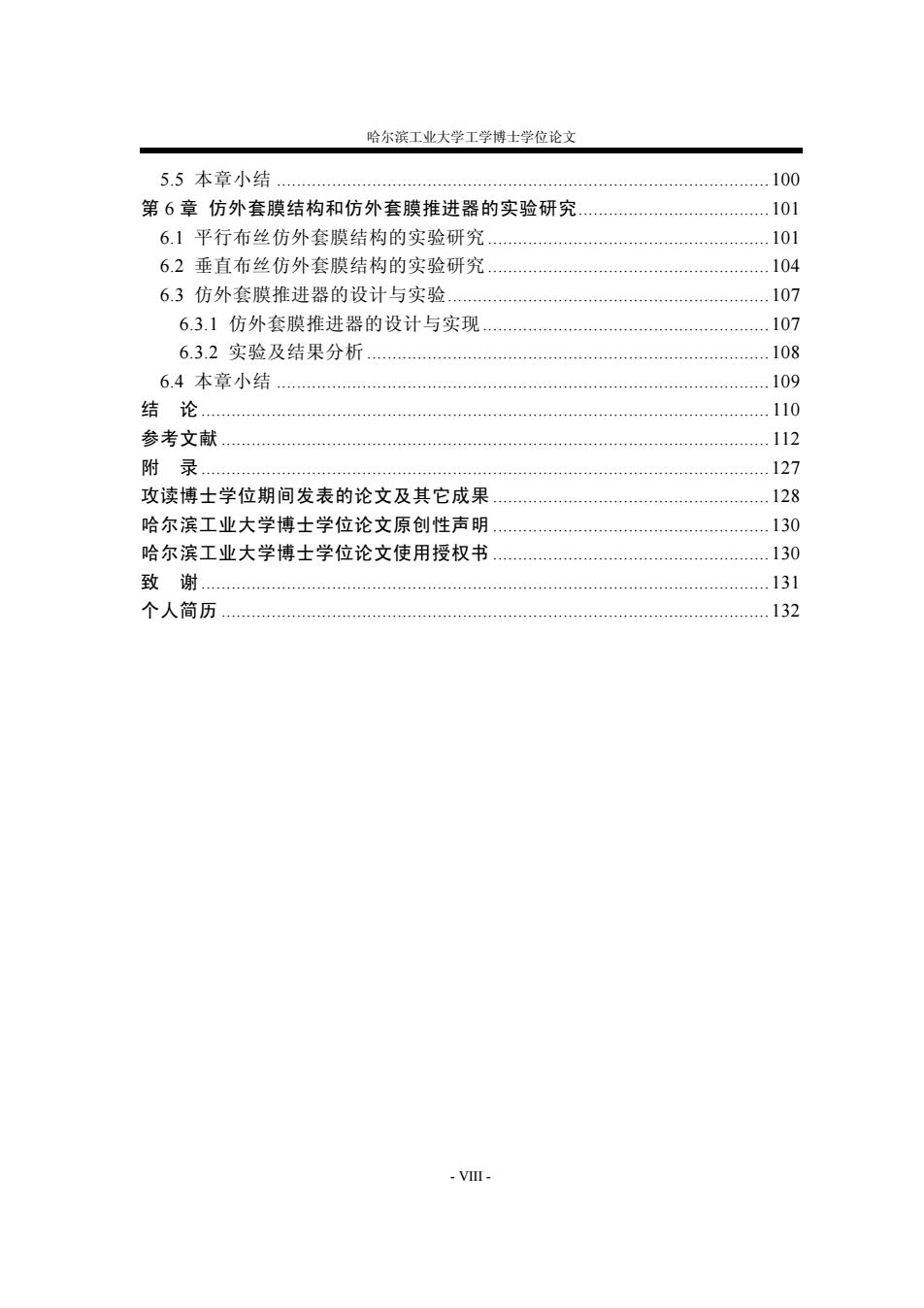
哈尔滨工业大学工学博士学位论文 5.5本章小结 100 第6章仿外套膜结构和仿外套膜推进器的实验研究 101 6.1平行布丝仿外套膜结构的实验研究 101 6.2垂直布丝仿外套膜结构的实验研究 104 6.3仿外套膜推进器的设计与实验 107 6.3.1仿外套膜推进器的设计与实现 107 6.3.2实验及结果分析 108 6.4本章小结 109 结论 110 参考文献.… 112 附录 127 攻读博士学位期间发表的论文及其它成果 128 哈尔滨工业大学博士学位论文原创性声明 130 哈尔滨工业大学博士学位论文使用授权书 。。。。。。 130 致谢.… 131 个人简历 132
哈尔滨工业大学工学博士学位论文 - VIII - 5.5 本章小结 ..................................................................................................100 第 6 章 仿外套膜结构和仿外套膜推进器的实验研究......................................101 6.1 平行布丝仿外套膜结构的实验研究........................................................101 6.2 垂直布丝仿外套膜结构的实验研究........................................................104 6.3 仿外套膜推进器的设计与实验................................................................107 6.3.1 仿外套膜推进器的设计与实现.........................................................107 6.3.2 实验及结果分析 ................................................................................108 6.4 本章小结 ..................................................................................................109 结 论................................................................................................................. 110 参考文献 ............................................................................................................. 112 附 录.................................................................................................................127 攻读博士学位期间发表的论文及其它成果 .......................................................128 哈尔滨工业大学博士学位论文原创性声明 .......................................................130 哈尔滨工业大学博士学位论文使用授权书 .......................................................130 致 谢.................................................................................................................131 个人简历 .............................................................................................................132